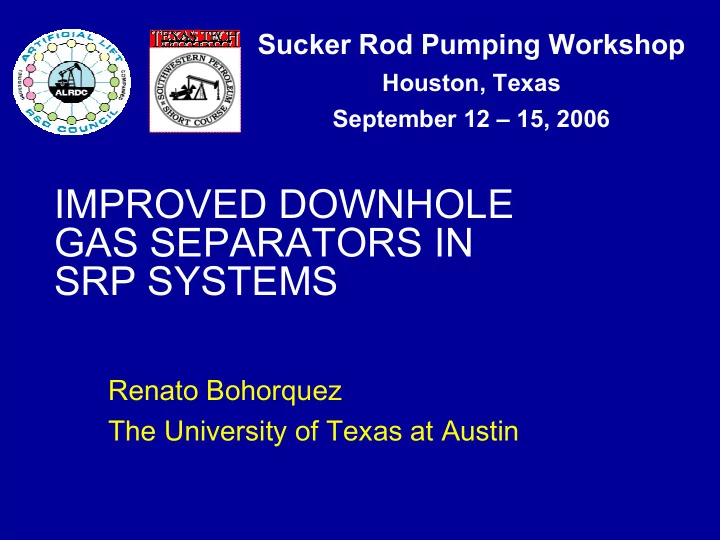

Sucker Rod Pumping Workshop Houston, Texas September 12 – 15, 2006 IMPROVED DOWNHOLE GAS SEPARATORS IN SRP SYSTEMS Renato Bohorquez The University of Texas at Austin
OUTLINE • PROBLEM DESCRIPTION • GRAVITY DRIVEN SEPARATORS • EXPERIMENTAL PROCEDURE • RESULTS • CONCLUSIONS 2006 Sucker Rod Pumping Workshop 2 Sept. 12 - 15, 2006
PROBLEM DESCRIPTION 100% liquid pump barrel fillage is desired. Otherwise: - Decreased volumetric efficiency - Fluid pound 2006 Sucker Rod Pumping Workshop 3 Sept. 12 - 15, 2006
PROBLEM DESCRIPTION Incomplete liquid barrel fillage using a “poorboy” gas separator Delayed opening of traveling valve 2006 Sucker Rod Pumping Workshop 4 Sept. 12 - 15, 2006
GRAVITY DRIVEN SEPARATORS Gas bubble’s position in separator annulus: V gas =V liquid -V slip (downward velocity) V slip =6 in/s for low viscocity fluids – Bubble size – Fluid viscocity – Density difference 2006 Sucker Rod Pumping Workshop 5 Sept. 12 - 15, 2006
Varying liquid velocity during the upstroke in separator annulus A plunger = V V liquid plunger A annular Conventional, D plunger =1in, L s =86in, 8.45spm, 200BPD 2006 Sucker Rod Pumping Workshop 6 Sept. 12 - 15, 2006
Gas bubble flow path over several strokes Conventional Pump. D dip tube =1.5 in, Conventional Pump. D dip tube =1.5 in, D plunger =1 in, Ls=86 in , 8.45 SPM D plunger =1 in, Ls=86 in , 8.45 SPM time (s) 0 5 10 15 20 0 1 st Stroke 3 rd Stroke 2 nd Stroke bubble position (in) . 5 10 15 20 25 30 35 40 45 50 2006 Sucker Rod Pumping Workshop 7 Sept. 12 - 15, 2006
Gas bubble’s net velocity,V net V net =V avg. upstroke (downward) - V avg. downstroke (upward) V net ≤ 0 : No gas enters dip tube V net > 0 : Gas will enter dip tube (if upstroke duration = downstroke duration) Is a long downhole gas separator needed ? 6 ft is enough (Lisigurski) 2006 Sucker Rod Pumping Workshop 8 Sept. 12 - 15, 2006
EXPERIMENTAL PROCEDURE LABORATORY FLOWLOOP SCHEMATIC Allows intermittent flow 2006 Sucker Rod Pumping Workshop 9 Sept. 12 - 15, 2006
Intermittent flow conditions Automated butterfly valve Program motor to set pumping speed i.e. Open for 3 s. and close for 3 s. 10 SPM 2006 Sucker Rod Pumping Workshop 10 Sept. 12 - 15, 2006
RESULTS Increased number of holes in a “poorboy” Will this improve the operational range? Extra foot with 12 more 3/8” holes 2006 Sucker Rod Pumping Workshop 11 Sept. 12 - 15, 2006
Poorboy 1 Poorboy 6 (12 holes along 1 ft) (24 holes along 2 ft) 2006 Sucker Rod Pumping Workshop 12 Sept. 12 - 15, 2006
Changing entry port geometry PATTERSON ECHOMETER 2006 Sucker Rod Pumping Workshop 13 Sept. 12 - 15, 2006
Can we go beyond 6 in/s ? 2006 Sucker Rod Pumping Workshop 14 Sept. 12 - 15, 2006
Separator annular area effect Bubble size inside separator Mud Anchor – Dip tube annular area Using 1 in. OD DT: 5.154 in 2 Using 1.5 in. OD DT: 4.172 in 2 19% less space than with 1 in. DT 2006 Sucker Rod Pumping Workshop 15 Sept. 12 - 15, 2006
The ‘pump’ stroke 2006 Sucker Rod Pumping Workshop 16 Sept. 12 - 15, 2006
Smaller annular space allows more gas bubbles coalescence Hence, higher gas bubble rise velocity 2006 Sucker Rod Pumping Workshop 17 Sept. 12 - 15, 2006
As well as increased liquid velocity At similar superficial liquid velocities, the liquid holdup is smaller for smaller annular spaces 2006 Sucker Rod Pumping Workshop 18 Sept. 12 - 15, 2006
Entry port position relative to perforations 32’’ Entry ports above Entry ports in front the perforations the perforations 2006 Sucker Rod Pumping Workshop 19 Sept. 12 - 15, 2006
Placing entry ports in front the perforations is better than above 2006 Sucker Rod Pumping Workshop 20 Sept. 12 - 15, 2006
CONCLUSIONS • What we learnt before (Lisigurski and Guzman): – If we have enough rathole to set the pump intake below the perforations (at least 6 ft), we do not need a downhole gas separator. – Multiple rows of slots are not necessary. – The width of the slot is not important, but the total area is. – Maximize diameter of the dip tube (avoid high pressure drops). – It is not necessary to have a long dip tube (6 ft is enough). 2006 Sucker Rod Pumping Workshop 21 Sept. 12 - 15, 2006
CONCLUSIONS • Developments: – Increasing the number of holes in a “poorboy” separator improves the operational range. – Having an entry port area half the size of the mud anchor-dip tube annular area is sufficient (as seen with the “poorboy” with 24 holes). – Changing the entry port geometry has no significant impact on downhole gas separator efficiency. – Placing the separator entry ports in front of the perforations is better than placing them above the perforations (Guzman). – Decreasing the separator annular area • Increases bubbles coalescence. • Increases liquid effective velocity. 2006 Sucker Rod Pumping Workshop 22 Sept. 12 - 15, 2006
CONCLUSIONS - All gravity driven separators tested are limited by the 6 in/s threshold; and, - changing the entry ports configuration does not have a significant impact. - So, changing the inside of the separator should be tried. • Future work: – Centrifugal downhole gas separators (early testing already in progress) – Study effect of pumping speed – Study effect of changing liquid’s viscocity 2006 Sucker Rod Pumping Workshop 23 Sept. 12 - 15, 2006
ACKNOWLEDGEMENTS Yates Petroleum Inc. THANK YOU FOR YOUR ATTENTION ANY QUESTIONS ? Special thanks to: Omar Lisigurski, Manuel Guzman, Tony Bermudez, Victor Ananaba, Dagoberto Romer 2006 Sucker Rod Pumping Workshop 24 Sept. 12 - 15, 2006
Recommend
More recommend